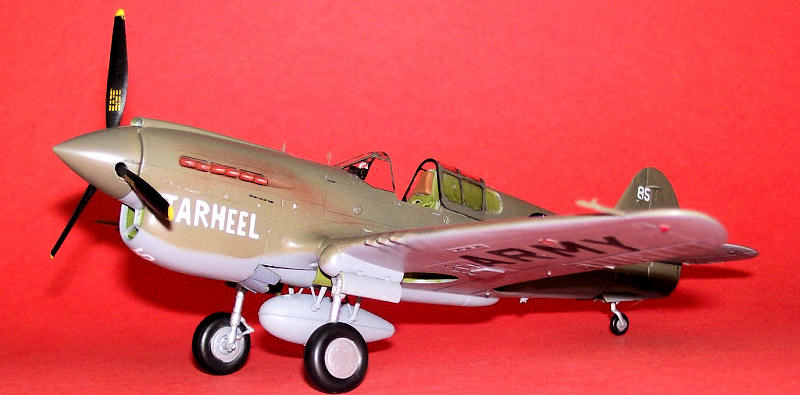
Hasegawa 1/48 P-40E Warhawk
| KIT #: | 09635 |
| PRICE: | CDN $32.48 |
| DECALS: | Three options |
| REVIEWER: | Pablo Calcaterra |
| NOTES: | Superscale 48-492 Decals used |

| HISTORY |
I am not going to dwell into lots
of details about George Preddy’s story with the P-40. Tom Cleaver’s article (kit
09086) in Modeling Madness retells the actions in which the 49th
Group was involved in
George Preddy later became the third
highest scoring American ace in the ETO, the seventh highest scoring American
ace, and is the top P-51 Mustang ace.
But let me share with you the story BEFORE
George Preddy was born in
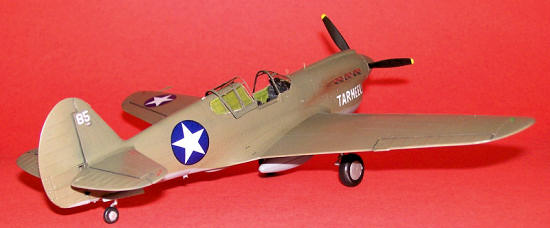 which
depicted him as he was small and had large ears (during the war his friends
turned his nickname into Ratsy!)
which
depicted him as he was small and had large ears (during the war his friends
turned his nickname into Ratsy!)
An example of his good heart is that
when he learnt that one of his new friends at the YMCA had lost his mother some
years ago, he offered him to live with the Preddy family, which “Bozo” Boaz
happily accepted.
George worked at the cotton mill to save money
for his College studies. He was president of a social club while in high school.
It was called the GUB Club. And here were some of his great friends: Bozo,
George and Otto built a tree house
and hung ropes from trees. They moved from tree to tree like monkeys. They were
also always fighting, most of the times George losing to the larger football
player Otto. But George never gave up!
College was a means for George to learn to fly.
Three years after he graduated from high school he was able to fly for the first
time. Hal Foster, a friend of the family took him on a ride to
His instructor was Bill Teague, who owned a
His father granted him permission to try to
enter the Navy and became an aviator (
He decided to improve his body by
strict exercise and his height by getting Bill and Bozo to pull from him! During
the summer of 1940 they finally went on the barnstorm tour. One incident that
happened during the trips around the mountains is that they found that a little
girl was very ill with pneumonia. At no cost, they flew her to the closest
airport. Later on they learnt that the girl had fully recovered.
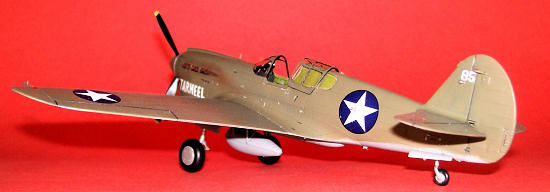 Decided
that he was going to fly in fast planes, he passed the exams at the Army Air
Corps. He enlisted as a cadet in the National Guard. Immediately he asked to be
transferred to the Air Corps, but weeks passed before they answered. Just before
his unit was going to be transferred to
Decided
that he was going to fly in fast planes, he passed the exams at the Army Air
Corps. He enlisted as a cadet in the National Guard. Immediately he asked to be
transferred to the Air Corps, but weeks passed before they answered. Just before
his unit was going to be transferred to
Slowly and steadily he made
progress, flying ever-faster planes. Just 5 days after the Japanese attack to
Pearl Harbor, George and his friends received their wings and he was transferred
to the 49th Pursuit Group, 9th
Pursuit Squadron (with P-39 Aircobras).
From this point onwards, you can
read Preddy’s story in
After the accident and his recovery, his was
sent to rest to the States. On
In those monsters he flew in the ETO during
1943, obtaining his first confirmed kill and being shot down into the
After his exploits as fighter pilot flying
Mustangs, he was licensed for some weeks and returned to the
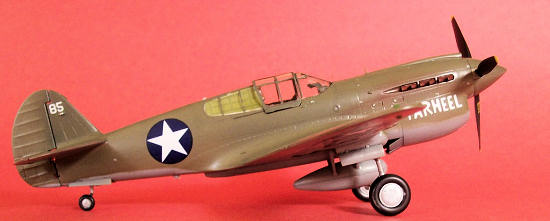 When he went
back to the ETO, he became Leader of the 328th
Squadron. Flying one the Mustangs and after achieving 4 more victories, he was
shot down and killed by friendly anti aircraft batteries while chasing a FW190
low over the Ardennes on December 24th,
1944.
When he went
back to the ETO, he became Leader of the 328th
Squadron. Flying one the Mustangs and after achieving 4 more victories, he was
shot down and killed by friendly anti aircraft batteries while chasing a FW190
low over the Ardennes on December 24th,
1944.
Now, you may wonder what is my
personal relation with George Preddy?
Well, in 2007 I had to travel from
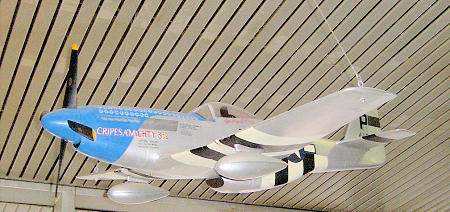 pictures
and text that described the exploits of the Preddy Brothers (George and Bill,
also a Mustang pilot shot down and killed shortly after George). While reading
the information, an elder gentleman approached me and explained me a little bit
more about George Preddy. He was very kind and suggested me buying a copy of
George Preddy’s biography at the bookstore located at the airport. I did so and
in fact bought the last hard cover copy left!
pictures
and text that described the exploits of the Preddy Brothers (George and Bill,
also a Mustang pilot shot down and killed shortly after George). While reading
the information, an elder gentleman approached me and explained me a little bit
more about George Preddy. He was very kind and suggested me buying a copy of
George Preddy’s biography at the bookstore located at the airport. I did so and
in fact bought the last hard cover copy left!
So back to work, then to  he
Preddy Memorial Foundation. I commented about the senior whom I had talked to,
and to my surprise, I leant that he was no other than Otto Gaskins, George’s
childhood best friend! He used to go every day to take care of the stand since
he retired in 1984 and in 2007 he was 92 years old!!!!
he
Preddy Memorial Foundation. I commented about the senior whom I had talked to,
and to my surprise, I leant that he was no other than Otto Gaskins, George’s
childhood best friend! He used to go every day to take care of the stand since
he retired in 1984 and in 2007 he was 92 years old!!!!
I decided to build George’s last
Mustang (published elsewhere with support from the PMF).
Last year (2009) I had to
repeat the same trip to 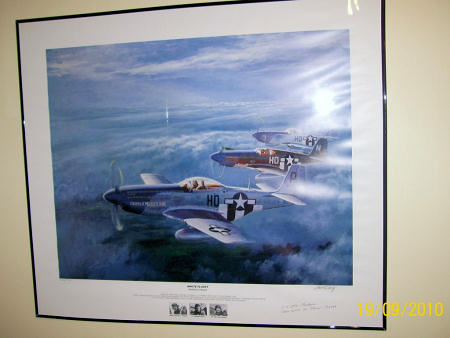 for
me! He led me to an area at the Airport that has several paintings remembering
George’s adventures in the war, I purchased two prints of the beautiful artwork
called White Flight (which describes the moments prior to George’s record 5
kills in one combat) that Otto graciously signed for me, and also got a PMF pin!
But it did not finish there. He led me to his house where he was living with his
wife and showed me pictures, books and other things from his times as a pilot in
the Amazons in the ‘50s in
for
me! He led me to an area at the Airport that has several paintings remembering
George’s adventures in the war, I purchased two prints of the beautiful artwork
called White Flight (which describes the moments prior to George’s record 5
kills in one combat) that Otto graciously signed for me, and also got a PMF pin!
But it did not finish there. He led me to his house where he was living with his
wife and showed me pictures, books and other things from his times as a pilot in
the Amazons in the ‘50s in
After the passing of Otto’s second
wife some months ago, he moved to a house close to his daughters in Chapel Hill,
NC and is not able to take care of the Preddy’s display at the airport anymore.
I have framed on the prints, gave
the second one to one of my Arg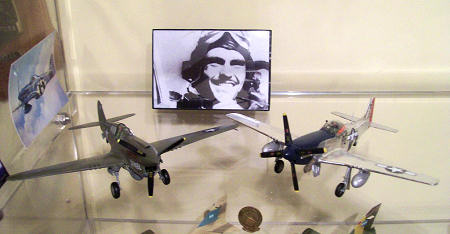 entina’s
Air Force veteran friend and decided to make a little memorial
at home to remember George Preddy. So I printed George’s picture that Otto likes
the most, framed it and placed it along Cripes A’Mighty 3rd,
the pin and now…Tarheel.
entina’s
Air Force veteran friend and decided to make a little memorial
at home to remember George Preddy. So I printed George’s picture that Otto likes
the most, framed it and placed it along Cripes A’Mighty 3rd,
the pin and now…Tarheel.
This article is dedicated to Otto
Gaskins, who is a shinning example of loyalty and friendship. After all those
years, Otto is still helping to keep his best friends’ memory alive.
Thanks, Otto!
| THE KIT |
Hasegawa’s Kittyhawk has decals to build 2 of Neville Duke’s North Africa planes. I searched for a P-40 that would allow me to build George first fighter…and my friends from Hornet Hobbies in Toronto found the Hase Kittyhawk. Wrong decals, but every single part that allows you to make the correct P-40…and many more! Two different types of rudder are supplied, along with different intakes and bits that allow you to build several configurations. From my point of view, good to have those options but the problem is that it is over engineered and therefore there are several unions of parts that need to be sanded out. More below…
| CONSTRUCTION |
Like always, I pre painted all the
interiors (cockpit, wheel wells, air intakes) in US Interior Green. Everything
fits really well. I added some PE seat belts from the spares. Instrument panel
was painted in black, dr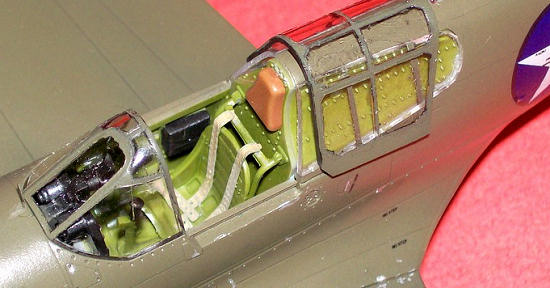 y
brushed in silver and drops of Future were added to replicate the face of the
gauges.
y
brushed in silver and drops of Future were added to replicate the face of the
gauges.
I put together the fuselage halves and added the back part of the fuselage (there is a small gap that I filled with Putty). In this picture you can also appreciate the amount of filler used to cover the gaps between fuselage and supplied headrest area.
Then I continued with the wings. Nothing special except some heavy use of Putty again, this time around the machine guns inserts.
There was a tiny gap in the top
union of the wings and fuselage that I corrected using Acrylic base, a brush and
a damp cloth.
Construction moved ahead pretty fast
with no other problem found except the ordinary sanding here and there.
The plane was ready to be painted.
| COLORS & MARKINGS |
After masking the cockpit and areas
to be protected, I tried to pre shade all the panel lines. Something I had not
tried in many years. It was not that bad!
Then I gave the undersides a coat in
Neutral Gray (MM Acrylic 4757), taking care to leave the black lines somehow
visible (but I was not very successful on this side of the plane)
I masked the undersides and moved to
the topside. Here Olive Drab
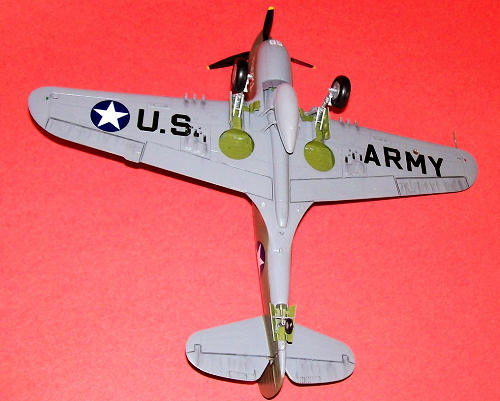 (MM Acrylic
4728) worked much better and managed to get a decent, though subtle, pre shade.
(MM Acrylic
4728) worked much better and managed to get a decent, though subtle, pre shade.
Using sanded black and rust pastels
and a brush I dirtied the plane here and there (exhausts, machine guns, moveable
surfaces, etc).
I added the wheels and gave the kit
a coat of Future. After the application of Future I added some “chipping” with a
silver pen.
I stated in the initial information,
I used Superscale decals. The Superscale set represents the first version of
George’s Tarheel, before the puffing dragon was added to the right side of the
nose.
They adhere very well, have good registry but…the white has lots of “pixels” and it does not back the blue color completely (national insignias) so you end up with two shades of blue…a lighter in the center and a darker “rim”.
They went very well with Set and Sol
and conformed very well to the panels.
One thing missing in the SuperScale
set (probably because they assume you’ve bought an American kit and not a
British one…ahem!) is the “U.S. Army” lettering for the undersides.
As I had built the Otaki P-40 many years ago, I was able to retrieve these decals. But they were yellowed. So I had to trim all the clear carrier film, one by one, and put them in place. Instead of putting 2 decals, I had to apply 8! But they withstood very well my treatment.
| FINAL CONSTRUCTION |
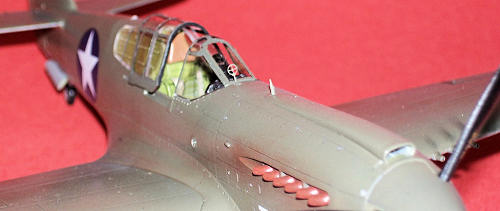 The
standard steps to finish the plane took place:
The
standard steps to finish the plane took place:
Propeller, propeller hub, wheels,
wheels doors, antenna, gunsight, canopy and details here and there.
I painted the formation lights and
the plane was finished when I glued the windshield.
| CONCLUSIONS |
An excellent kit, easy to assemble
as any Tamigawa one!
| REFERENCES |
George Preddy, Top Mustang Ace (Joe
Noah and Samuel L. Sox, Jr)
Preddy Memorial Foundation website
Conversations with Otto Gaskins and
his daughter Twink Lester
September 2010
If you would like your product reviewed fairly and quickly, please
contact
me or see other details in the
Note to
Contributors.